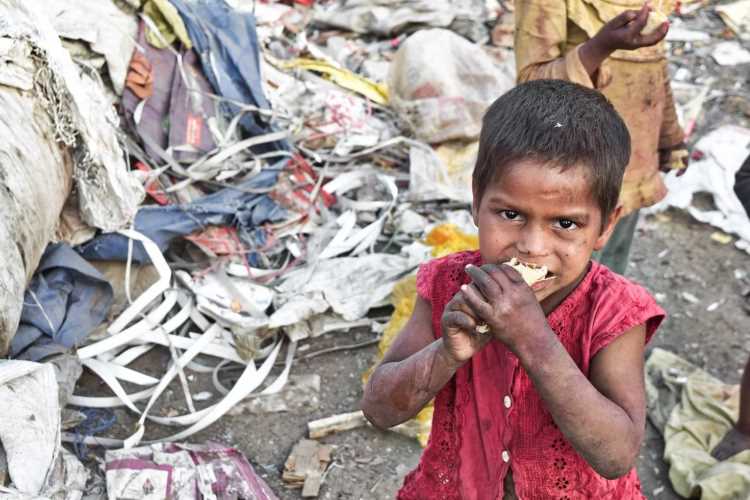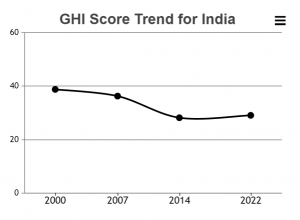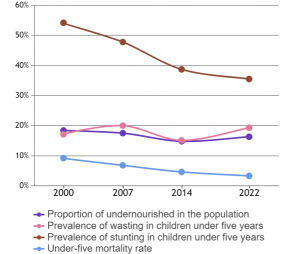
Every time the Global Hunger Index (GHI) is released, concerns are raised by many about the ranking of India, given the apparent economic and social progress made by the country. In the 2022 Global Hunger Index, India ranks at 107th position out of 121 countries. With a score of 29.1, the GHI report describes India’s level of hunger as serious. The GHI score is a weighted average of the following four indicators.
Undernourishment: The percentage of the population with insufficient caloric intake.
Child stunting: The percentage of children under age five who have low height for their age, reflecting chronic undernutrition.
Child wasting: The percentage of children under age five who have low weight for their height, reflecting acute undernutrition.
Child mortality: The percentage of children who die before their fifth birthday, partly reflecting the fatal mix of inadequate nutrition, unhealthy environments, metabolism, etc.
In the calculation of GHI, these indicators respectively get a weight of one-third, one-sixth, one-sixth and one-third.
READ I Amid hunger index row, concerns over plummeting foodgrain stocks
Global Hunger Index: A measure of hunger?
A look at the indicators used to calculate the Global Hunger Index suggests that they do not necessarily measure hunger, making the name ‘hunger index’ a misnomer. Three (stunting, wasting and under 5 mortality) out of the four indicators relate to children under five years of age, indicating that it is not representative of the entire population.
Moreover, these indicators are outcomes of complex interactions of various factors like nutrition, drinking water, sanitation, genetics, environment, and capacity to utilise food. Calculating hunger index mainly based on child health indicators that carrying a weight of 67% is not appropriate. So, index is not representative of hunger and it does not cover the entire population.
The data for indicators used in GHI is reported to have been taken from established international sources. While the data for the three indicators related to the under-five population is from UN sources, the data on the most important indicator – the proportion of undernourished population is based on a survey conducted on a small sample that doesn’t account for India’s diversity.
Reasons for India’s low rank
Even though the general perception is that India cannot rank so below in hunger, it is worthwhile to look at some of the reasons behind such a poor ranking. The main issue in constructing any index is the quality of data represented by its timely availability, collection processes, extreme values and statistical significance of data.
Delayed data availability: The UN Inter-agency Group for Child Mortality Estimation which estimates the under-five mortality rates has stated the following:
Timely and reliable data on child mortality for all countries remain elusive. On average, the most recent quality data point on child mortality across all countries was 4.8 years old, with only half the countries in the world having a data point within the past 3.5 years. For about a third of all countries, the latest available child mortality data point was more than five years old. In just 40 countries, good-quality national data was available.
It is worthwhile to mention that India has a sound statistical system namely the Sample Registration System which provides annual estimates on under-five mortality with a lag of one year. India also has alternative data sources like National Family Health Survey which serve as validation check on quality of the estimates from the alternative sources.

![]()

Poor data gathering practices: There is absolutely no reason why the country’s undernourishment levels should increase when the FAO’s estimate on per capita dietary energy supply has been increasing year-on-year due to enhanced production of major agricultural commodities. The agency also seems to have not taken into account the massive government measures undertaken to ensure food security during the Covid-19 period. The FAO estimate of proportion of undernourished population in India also uses data from a survey with a small sample size that used the following questionnaire.
During the last 12 months, was there a time when, because of lack of money or other resources:
- You were worried you would not have enough food to eat?
- You were unable to eat healthy and nutritious food?
- You ate only a few kinds of foods?
- You had to skip a meal?
- You ate less than you thought you should?
- Your household ran out of food?
- You were hungry but did not eat?
- You went without eating for a whole day?
One can see that these questions are not standardized, cannot have specific responses and the responses are bound to be highly subjective.
Unimaginative values given to indicators: An examination of the data on child wasting reveal that India has the highest percentage (among all countries) of under-five children who have low weight for their height (wasting). It is beyond comprehension how India can have the highest value for this indicator. Although the quality of other indicators used in the Global Hunger Index is also questionable, the ranking of India will jump by about 10 points if this unreliable indicator on child wasting is removed from GHI.
Varying statistical significance of indicators: An examination of the estimates of under-five mortality rate by the UN Inter-agency Group for Child Mortality Estimation revealed that the data quality of different countries varied significantly as demonstrated by the country specific confidence intervals associated with the estimated value of the indicator. In general, there is need for a thorough examination of the quality of data of all the indicators used in the GHI.
The Global Hunger Index is a misnomer for hunger as the indicators that go into the construction of the index are not representative of the entire population. The data used for calculation the index also have severe quality and relevance issues. There is an urgent need to review the indicators used in GHI to make them more broad-based, making the index representative of hunger and the entire population.
(Dr Rattan Chand is director, EGROW Foundation, a Noida-based think tank.)

